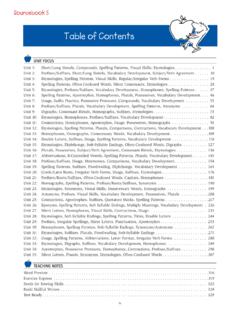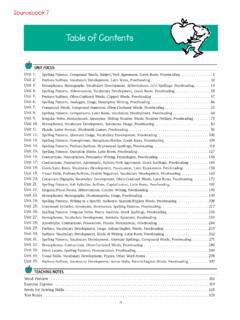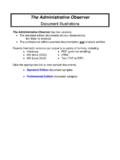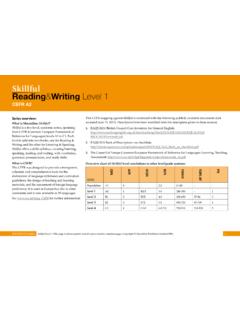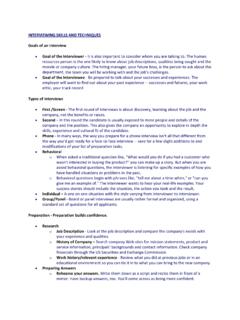Transcription of Communicative Discourse in Second Language Classrooms ...
1 Communicative Discourse in Second Language Classrooms : From Building Skills to Becoming skillful Mahmoud Suleiman California State University, Bakersfield A Paper Presented at the National Social Science Association Conference March 24-26, 2013 Las Vegas, Nevada 2 ABSTRACT The dynamics of the Communicative Discourse is a natural process that requires an application of a wide range of skills and strategies. In particular, linguistic Discourse and the interaction process have a huge impact on promoting literacy and academic skills in all students especially English Language learners (ELLs).
2 Using interactive approaches in Second Language Classrooms is very critical in helping ELLs in not only in building necessary skills, but more importantly becoming skillful in undertaking academic and literacy tasks. In addition, key contextual demands and conditions for effective Discourse in the classroom should be created. This paper examines the anatomy of the speech event and draws pedagogical implications that will assist teachers in making necessary adaptations for ELLs. 3 Communicative Discourse in Second Language Classrooms : From Building Skills to Becoming skillful Mahmoud Suleiman California State University, Bakersfield Introduction The anatomy of Language development can help in understanding how linguistic behavior is developed and shaped later on in children s lives.
3 At the same time, it can be an indicator of how Language and literacy develop at different stages. This awareness about the process of Language development can eventually help educators in providing necessary ingredients and creating conducive conditions for nurturing students linguistic and academic skills in schools and beyond. Understanding first Language acquisition has been associated with interpreting how children s cognitive abilities develop. For many years, studying how humans acquire their first Language has been the focus of study by psychologists and linguists alike.
4 Although views vary on how children acquire their first Language , there is a general agreement among researchers that acquiring a Language is a complex mental, psychological and social activity. Research on how a child acquires a first Language has become the basis for understanding how Second and foreign Language learning occurs. Many correlations have been made in an attempt to account for the process in Second and foreign Language Classrooms . In addition, 4 bilingualism (which is the focus of another chapter) has drawn much of its models and approaches from the existing research and empirical data of Second Language acquisition studies which have attempted to account for the bilingual development in learners acquiring two or more languages during their early and advanced stages of life.
5 Additionally the process of Second and foreign Language development is better understood through the distinction between the two languages at hand: the first Language of the learner (L1) and the Second and/or foreign Language (L2). The Second and/or foreign Language is also referred to as the target Language (TL). The L1 and L2 (TL) of the learner interact in many interesting ways. This interaction has been a focus of study by linguists, psychologists, and Language educators for a long time. While views vary on their theoretical foundations, they serve as a helpful frame of reference upon which Language teachers can base their instructional choices in the classroom.
6 Views on first Language acquisition and Second /foreign Language learning have deep roots in such fields as such as psychology, linguistics and many feeder sub-fields in education (such as sociology, anthropology, ethnography and the like). In fact, many of these fields (namely sociology, anthropology, ethnography and the like) have contributed largely to the landmark and current linguistic models and theories of first, Second , and foreign Language acquisition. Thus, multiple perspectives abound about Language acquisition from the lenses through which one examines related phenomena.
7 These perspectives are equally significant for Language teachers and educators. It is important that keep in mind that Language acquisition is viewed within the context of Language s natural ecological place of human interaction. Therefore, the ecology of Language acquisition will be illustrated by casting light on key ingredients that conceptualize various 5 complex phenomena related to Language development. A conceptual framework is presented based on the landmark and current theories that characterize the process and product of Language acquisition.
8 The implications of various approaches to Language acquisition are enormous, so drawing upon views and models can help in bridging the theoretical gaps and assist teachers in formulating a sound rationale that justifies their practices in learning/teaching situations. Similarly, diversity of opinions are expected given the nature of issues studied thus leaving a wide range of options for teachers to consider in their efforts to integrate a viable eclectic approach that can inform their instruction. Accordingly, this paper provides an overview of basic approaches and perspectives on Language acquisition as a frame of reference to account for how the process and product of Language development are achieved.
9 Although there is no consensus among these theories and approaches, examining the basic tenets of each will help in providing Language teachers and educators of the knowledge base needed to effectively work with students in Second /foreign Language Classrooms . While substantiating some foundational principles from various theories/approaches that characterize the process of Language development, the paper draws pedagogical implications from the existing models and approaches that can enhance the learning and teaching outcomes in linguistically diverse settings.
10 Divergent Views on Language Acquisition It is worthwhile to examine some of the current and widely adopted perspectives and views on Language acquisition. Given the voluminous literature and research in the field, few will be highlighted that have come to shape the pedagogical practices especially in Language instruction (including Second and foreign languages) in schools today. 6 As pointed out earlier, studying how Language is acquired has been a focal point of interest in various fields such psychology, linguistics and education in general.













